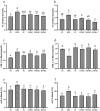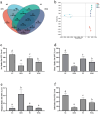Fig Meal Replacement Powder Ameliorates Obesity, Oxidative Stress and Intestinal Microbiota in Mice Fed With High-Fat Diet
- PMID: 40260060
- PMCID: PMC12009752
- DOI: 10.1002/fsn3.70104
Fig Meal Replacement Powder Ameliorates Obesity, Oxidative Stress and Intestinal Microbiota in Mice Fed With High-Fat Diet
Abstract
Figs, known for their high-antioxidant capacity, have shown potential in regulating obesity. However, research on fig-based products and the mechanisms behind their effects remains limited. This study aims to systematically evaluate the potential of fig meal replacement powder (FMRP) in regulating obesity and mitigating obesity-induced oxidative stress through both in vitro and in vivo experiments, while also elucidating its underlying mechanisms. The results demonstrated that FMRP exhibited superior nutritional value and antioxidant activity compared to commercially available alternatives. Furthermore, FMRP significantly reduced weight gain, improved lipid metabolism, alleviated liver damage and oxidative stress, and positively modulated the gut microbiota in high-fat diet (HFD)-fed mice. Gut microbiota analysis showed that FMRP could restore the gut microbiota of hfd mice. For instance, it reduced the Firmicutes/Bacteroidetes (F/B) ratio. The correlation analysis has revealed the key bacterial genera related to obesity and oxidative stress. The key bacterial genera related to obesity include Desulfovibrio, Lachnoclostridium, etc., while the key bacterial genera related to oxidative stress include Bifidobacterium, Lactobacillus, and Turicibacter, etc. In conclusion, FMRP effectively alleviates oxidative stress, improves lipid metabolism, and modulates the gut microbiota, highlighting its potential as a functional food for obesity management.
Keywords: antioxidant; gut microbiota; meal replacement powder; obesity.
© 2025 The Author(s). Food Science & Nutrition published by Wiley Periodicals LLC.
Conflict of interest statement
The authors declare no conflicts of interest.
Figures







Similar articles
-
Curcumin alleviates high-fat diet-induced hepatic steatosis and obesity in association with modulation of gut microbiota in mice.Food Res Int. 2021 May;143:110270. doi: 10.1016/j.foodres.2021.110270. Epub 2021 Mar 9. Food Res Int. 2021. PMID: 33992371
-
Adzuki Bean Alleviates Obesity and Insulin Resistance Induced by a High-Fat Diet and Modulates Gut Microbiota in Mice.Nutrients. 2021 Sep 17;13(9):3240. doi: 10.3390/nu13093240. Nutrients. 2021. PMID: 34579118 Free PMC article.
-
Pistachio Consumption Alleviates Inflammation and Improves Gut Microbiota Composition in Mice Fed a High-Fat Diet.Int J Mol Sci. 2020 Jan 6;21(1):365. doi: 10.3390/ijms21010365. Int J Mol Sci. 2020. PMID: 31935892 Free PMC article.
-
Gut microbiota mediates the protective effects of dietary β-hydroxy-β-methylbutyrate (HMB) against obesity induced by high-fat diets.FASEB J. 2019 Sep;33(9):10019-10033. doi: 10.1096/fj.201900665RR. Epub 2019 Jun 5. FASEB J. 2019. PMID: 31167080
-
Quinoa Reduces High-Fat Diet-Induced Obesity in Mice via Potential Microbiota-Gut-Brain-Liver Interaction Mechanisms.Microbiol Spectr. 2022 Jun 29;10(3):e0032922. doi: 10.1128/spectrum.00329-22. Epub 2022 May 18. Microbiol Spectr. 2022. PMID: 35583337 Free PMC article.
References
LinkOut - more resources
Full Text Sources

